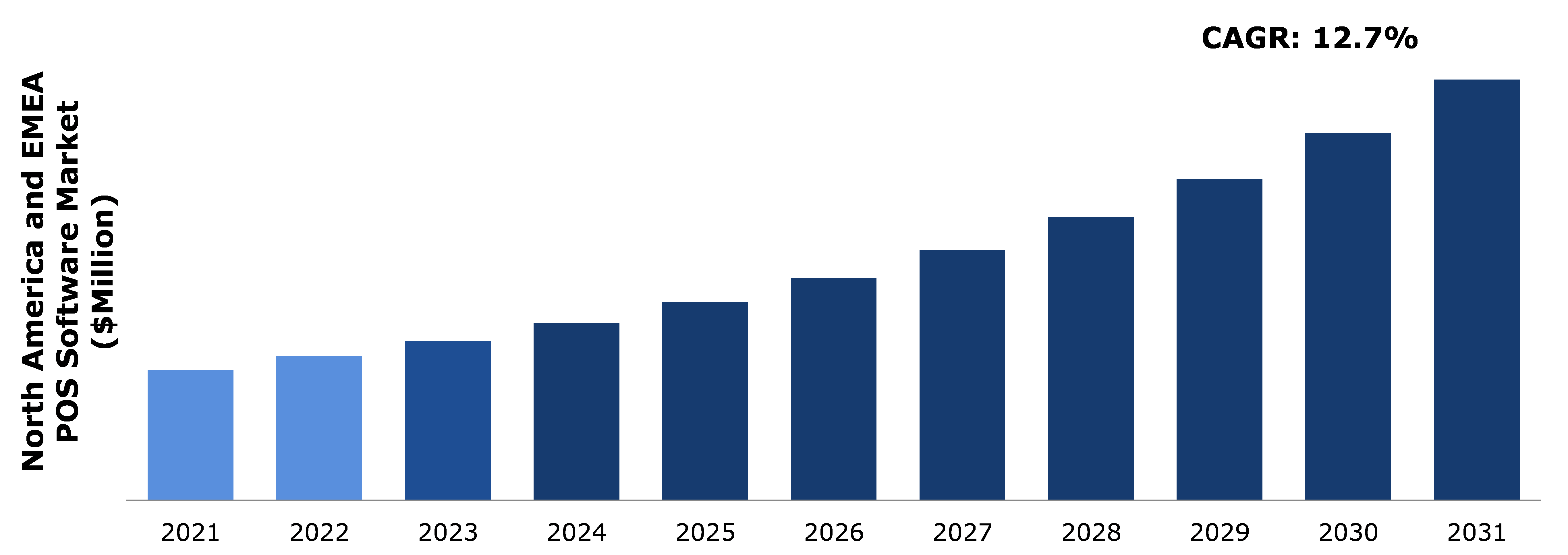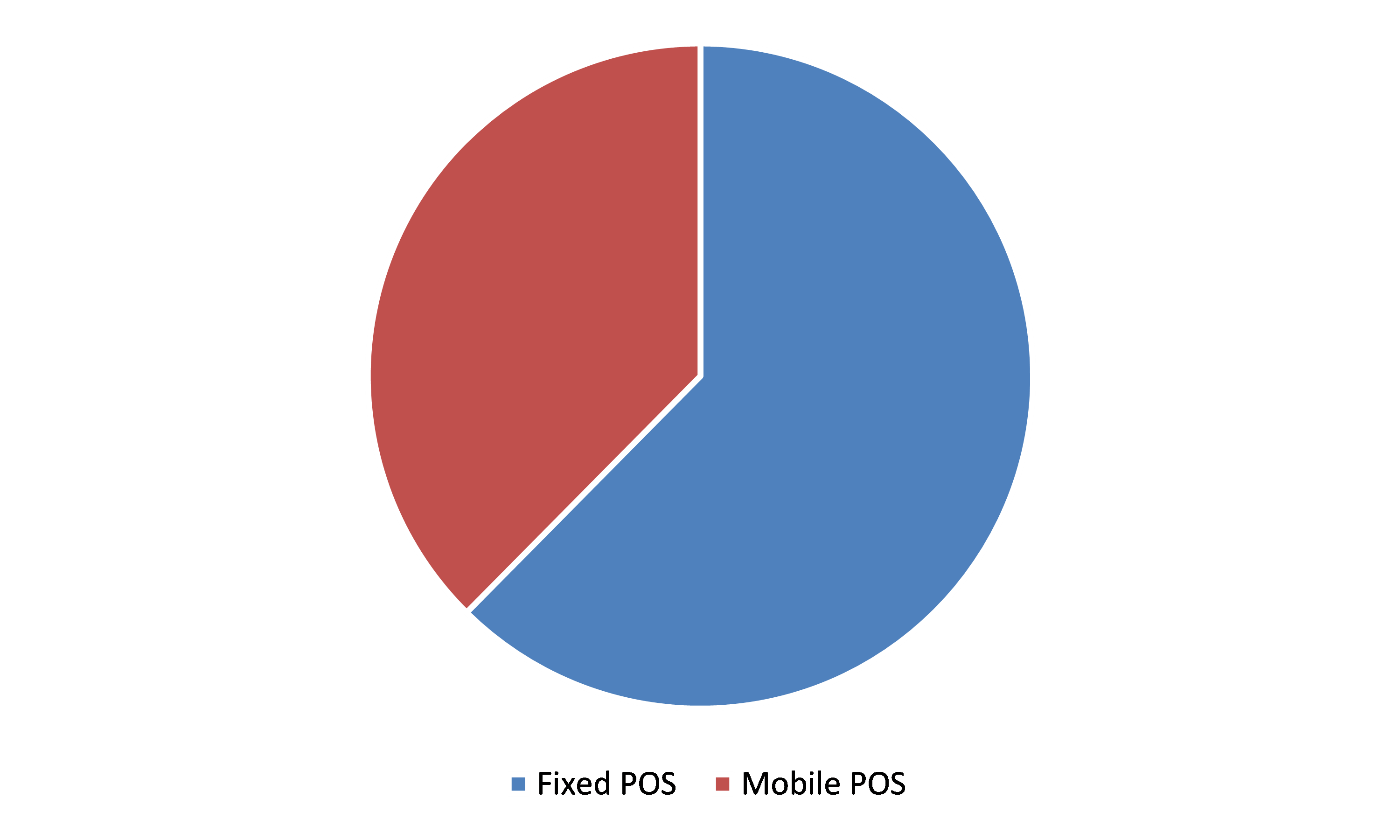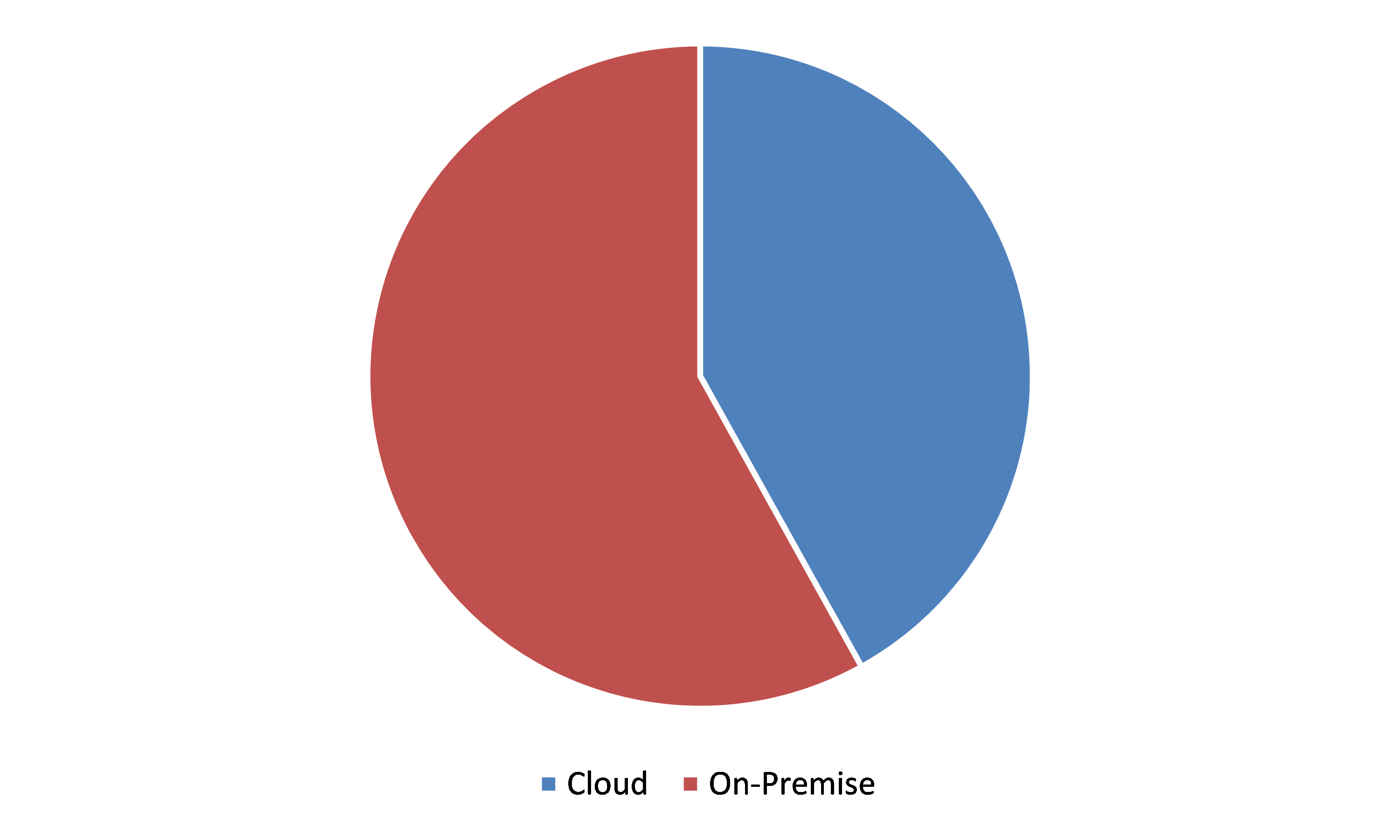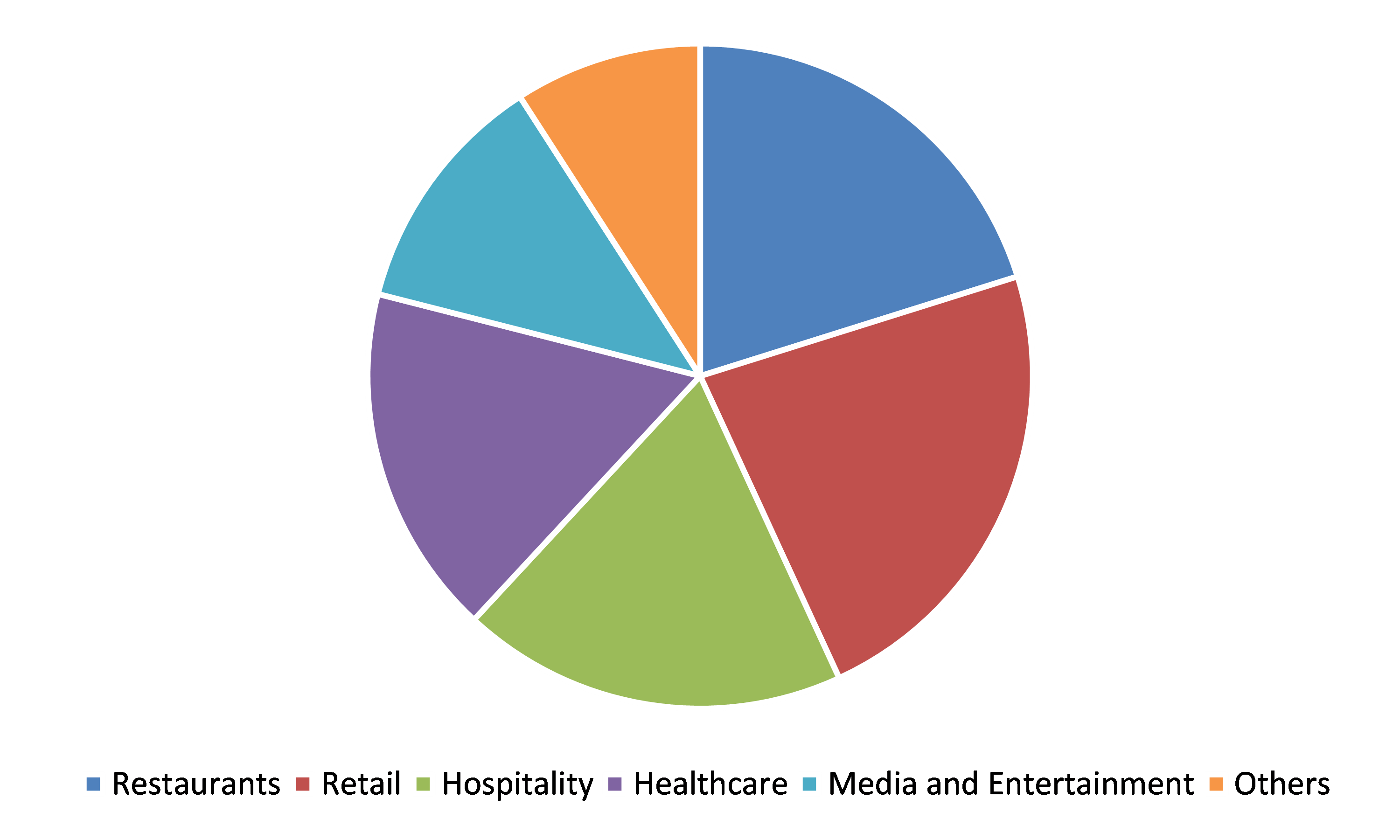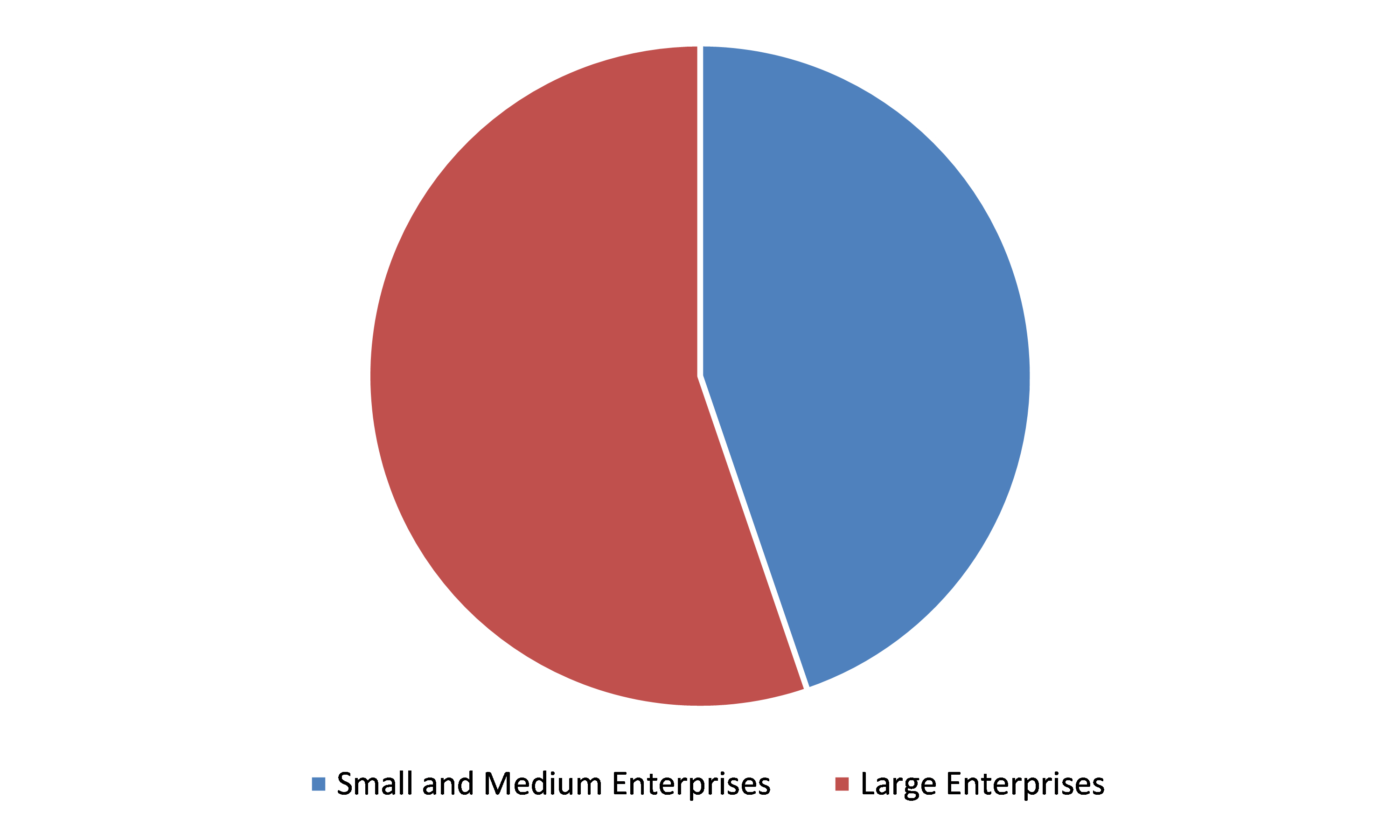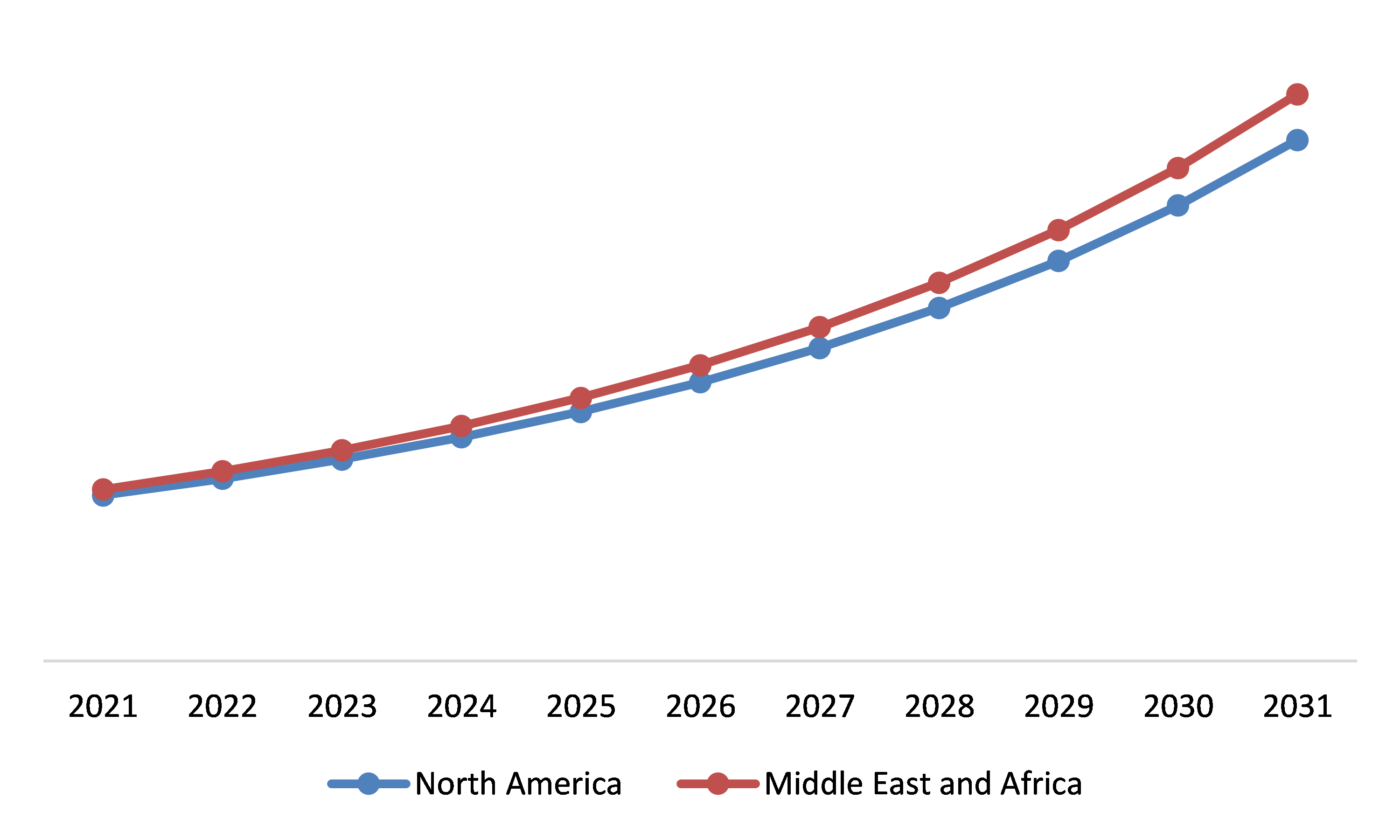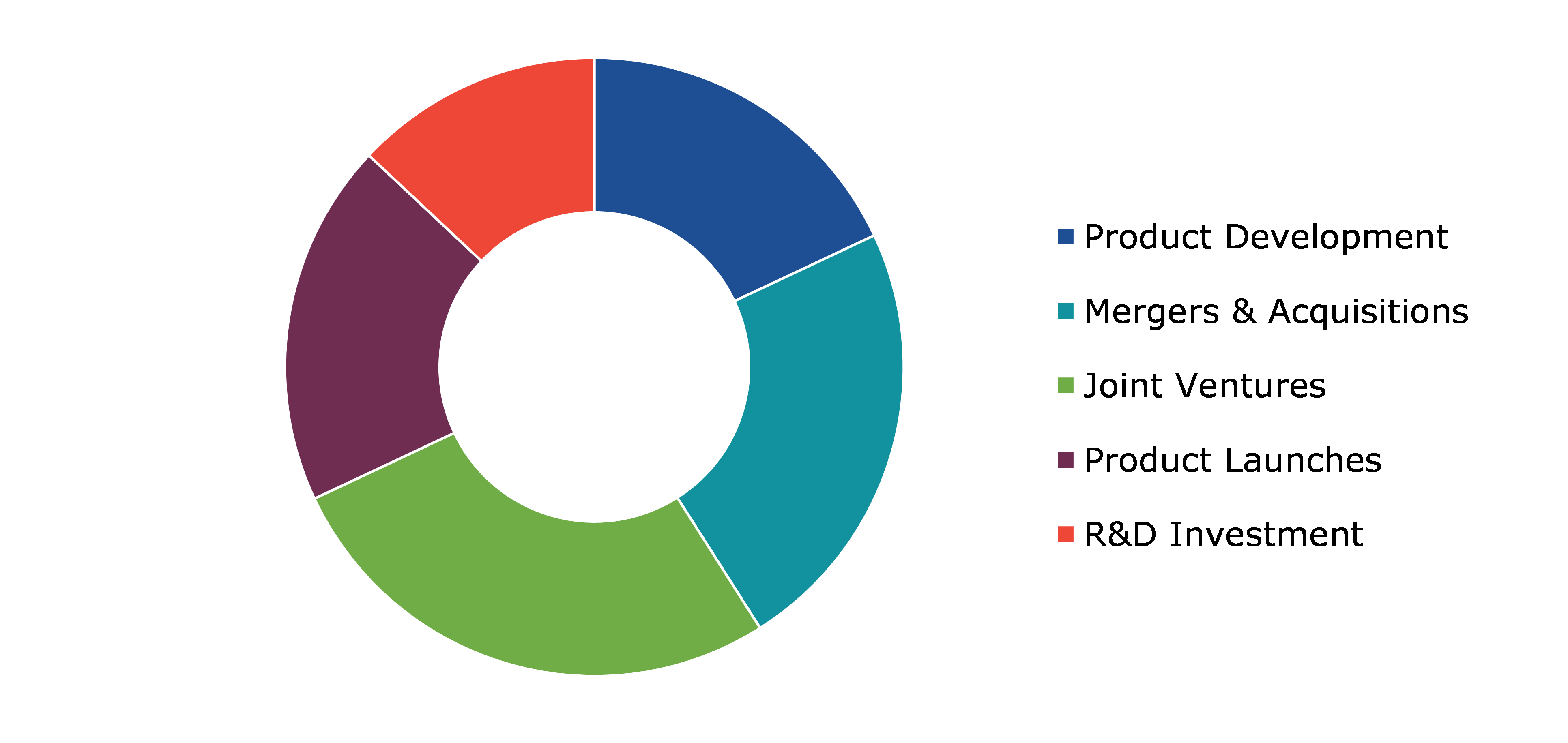NA And EMEA POS Market Report
RA08633
NA and EMEA POS Market by Application (Fixed POS and Mobile POS), Deployment Mode (Cloud and On-Premises), End User (Restaurants, Retail, Hospitality, Healthcare, Media & Entertainment, and Others), Organization Size (Small & Medium Enterprises and Large Enterprises), and Region (North America, Europe, Middle East, and Africa): Opportunity Analysis and Industry Forecast, 2022-2031
NA and EMEA POS Market Analysis
The NA and EMEA POS Market Size was $6,553.1 million in 2021 and is anticipated to expand at a CAGR of 12.7%, generating revenue of $21,140.1 million by 2031.
NA and EMEA POS Market Synopsis
Point of sale software solutions have been adopted by various sectors owing to its ability to offer advanced and custom analytical functions. This software aids the organizations with the help of significant software capabilities, such as support companies in streamlining day-to-day operations while permitting them to focus on their primary business tasks. Rise in demand for personalized check out system or point of sale software across a wide range of corporate applications is anticipated to drive the advancements of software solutions that work on the POS systems.
The increase in popularity of point of sale software across the retail and restaurant sector is major factor that is driving the NA and EMEA point of sale software market share growth. Rapid digitization and the increase in popularity of cashless transactions especially in the retail and restaurant sectors across North America, Europe, and the Middle East & Africa are estimated to drive the POS software popularity. Retail businesses have grown rapidly in the U.S. and the states namely California, Texas, and Florida have accounted for the majority of the retail trade businesses in this country.
Security risks and high cost of the software are the major factors that are anticipated to affect the growth of the NA and EMEA POS software industry in the near future. A significant amount of investment is needed while purchasing or renting hardware, whereas this is not often the case with software. However, the initial cost required for the procurement of the software is high and along with that additional fees are incurred for repairs and routine maintenance. In addition, some POS software services may charge up to 3% for each transaction, which may be excessive, particularly for a small business. These factors are anticipated to hamper the NA and EMEA POS software market share.
NA and EMEA POS Market Overview
Point of sale (POS) software plays a major role in processing customer transactions, providing regular updates on inventory levels, and accepting payments. The point-of-sale software can be on-premises or cloud-based. Some of the leading vendors for restaurant POS software include Toast, Bindo, Lightspeed, and Aloha. Latest innovations in POS software in terms of mobile technology, improved security measures, digital reward programs, and others are expected to have an impact on the point-of-sale software market during the forecast period. The retail POS software gained huge popularity owing to several features that it offers to retail establishments such as supply chain management, warehouse management, store budgeting, marketing automation, performance management, and supporting native mobile applications.
COVID-19 Impact on NA and EMEA POS Market
The COVID-19 pandemic negatively impacted the economy as governments worldwide imposed lockdowns and restrictions. During the pandemic, major countries governments were focused on sustaining economic growth. Owing to supply chain interruptions brought on by COVID-19, several industries were negatively impacted, which sparked a severe economic crisis.
However, the COVID-19 virus caused a significant increase in the adoption of point of sale software via physical or financial money transfers. The COVID-19 outbreak has completely changed the business landscape, requiring end users to acquire the most recent point-of-sale technology. The point of sale software solution has been upgraded and adopted by numerous retail and e-commerce platforms to allow online orders and payments. The integrated analytics of point-of-sale software can help understand & satisfy new consumer expectations, adapt to market change, and get ready for lockdowns or other similar events in the future.
To meet consumer demand during the pandemic by providing contactless product delivery at the doorstep, the retail business, hospitality sector, restaurants, and other sectors switched to online sales channels. Retailers and restaurants can now appreciate both online & in-store sale information and payment options to POS software suppliers who took advantage of the opportunity to improve their systems.
An Increase in the Popularity of Point-Of-Sale Software (Pos) Across the Retail and Restaurant Sector Is a Major Growth Driving Factor
Rapid digitization and the increase in popularity of cashless transactions especially in the retail and restaurant sectors across North America, Europe, and the Middle East & Africa are expected to drive the POS software popularity. Retail businesses are growing rapidly in the U.S. and the states namely California, Texas, and Florida have accounted for the majority of the retail trade businesses in this country.
Similarly, in Europe, the smaller Eastern European countries namely Slovenia and Lithuania have witnessed the highest growth rate in the retail sector along with huge markets namely France, Italy, and Spain. The world is entering a digital age and POS software has become vital for maintaining business records in the retail and restaurant sector. POS software finds a range of applications in the retail sector as it helps in generating an invoice for products & services, managing the customers, inventory, tracking purchases, analyzing sales trends, and managing the rewards for customers. In majority of the retail businesses, around 95% of the transactions take place via POS software, which include customer purchases, return history, tracking sales records, handling of payments, and information on stock inventory. The key features of point-of-sale software include lesser inventory overhead, quick report generation, speed up of busy checkout lines, generating more traffic online/offline for the store, and reduce time on back-office inventory functions.
To know more about the NA and EMEA POS market drivers, get in touch with our analysts here.
Expensive Software Upgrades and Security Risks Associated with Point-Of-Sale Software to Hamper the Market Growth
Although the point of sale software offers several benefits, the expensive software upgrades linked with the POS software are expected to hamper the NA and EMEA POS software market growth. For instance, for POS software upgrades, license renewals, operational licenses, and other upgrades, the vendors have to pay extra. This factor is expected to restrain the market growth. In addition, the growth of the POS software market is projected to be hampered due to hardware issues. For instance, in case of any hardware failure, the vendors must contact the POS providers to troubleshoot the issues.
Thus, rectifying the issues in POS hardware can be time-consuming and costly, as a specialized service technician is needed to fix the issue. In addition, there are security risks involved in POS software. For instance, when customers use credit or debit cards to make purchases, the chance of exposing personal information is high and POS providers must take precaution as digital payments may carry security risks. In some cases, POS software vendors charge extra fees or monthly subscription fees for data security. These factors are expected to hamper the point of sale software market demand in the upcoming years.
Technological advancements in the POS market is anticipated to generate excellent growth opportunities in the near future
The POS software has become an essential business tool that has replaced the traditional cash register and it is constantly evolving with the tech-driven solutions. Technological advancements such as untethered POS systems, seamless omnichannel experience, multiple payment methods, personalized shopping experience, POS data analytics, and cloud-based software are expected to generate excellent growth opportunities in the North America and EMEA POS software market. For instance, traditionally in the retail sector, the transactions used to take place at one location basically at the checkout counter. However, modern POS systems are untethered as they are mostly handheld devices and mobile POS due to which the transactions can take place from any location. Modern POS systems offer omnichannel experiences to retailers that create seamless customer experience with click-and-collect strategies as the customers can place order online and can pick-up products from the store. Even small businesses can accommodate the complex buying behaviors of customers to compete with larger companies.
To know more about the NA and EMEA POS market opportunities, get in touch with our analysts here.
NA and EMEA POS Market, by Application
On the basis of application, the market is divided into Fixed POS and Mobile POS.
NA and EMEA POS Market Share, by Application, 2021
Source: Research Dive Analysis
Fixed POS segment is projected to generate the maximum revenue, and mobile POS is anticipated to be the fastest growing during the forecast period. The fixed POS segment dominated the market share in the North America & EMEA point of sale software market and registered a large share of the revenue in 2021. The surge can be ascribed to most restaurants and retail shops' preference for a fixed POS system over a mobile POS system as fixed POS solutions offer more functionality and capabilities. Owing to benefits such as powerful management solutions with company functionality, staff time clocks, inventory management, a cash drawer, loyalty programs, and gift card administration, businesses are more likely to use a fixed POS system
NA and EMEA POS Market, by Deployment Mode
On the basis of deployment mode, the market is classified into cloud and on-premises. Among these, the cloud segment accounted for the highest revenue share in 2021.
NA and EMEA POS Market Size, by Deployment Mode, 2021
Source: Research Dive Analysis
The cloud segment is anticipated to have the maximum revenue and fastest market growth during the forecast period. The cloud segment is expected to contribute to the market growth in the near future. One of the major reasons organizations favor cloud deployment is the ability to operate the software remotely with better productivity and flexibility. Small and medium-sized organizations that require rapid software upgrades to support expanding business requirements can benefit from the cloud-based deployment.
NA and EMEA POS Market, by End User
On the basis of end user, the market is divided into restaurants, retail, healthcare, media & entertainment, hospitality, and others. Between the two, the retail segment is anticipated to grow at the fastest CAGR during the forecast period.
NA and EMEA POS Market Growth, by End User, 2021
Source: Research Dive Analysis
The hospitality sector can be characterized as a business that offers lodging, dining, food, and other associated services for the convenience and entertainment of tourists and guests.
Understanding point-of-sale software and systems is essential for people in the hospitality business to achieve long-term success. Business executives need to understand how its function in contemporary hotels, restaurants, & other comparable venues as along with its potential and it is so essential. In addition to their primary functions, such as accepting client cash and card payments, point-of-sale systems can be used for a variety of other tasks. The software assists firms to produce accurate and helpful reports, which include performance reports and employee reports. In the hospitality and restaurant industry, the use of point-of-sale systems is essential for success, however different restaurants use the software in different ways. To get the most from the POS system, it is recommended to always stay up to date with the emerging trends and upcoming technologies.
Since the emergence of cloud-based POS systems, the importance of POS systems has increased significantly. It is no longer adequate to compare a POS system to a retail cash register. These systems, which offer intelligent service options, have the power to fundamentally change the hospitality sector. For instance, Oracle ranks top in North America and is the world's second-largest provider of POS software. It also dominates the world in the hospitality market as most of its POS software installations are in North America. According to a study, Europe is the second-largest market, to use POS software in hospitality industry.
NA and EMEA POS Market, by Organization Size
On the basis of organization size, the market is classified into small & medium enterprises and large enterprises. Among these, the large enterprises segment accounted for the highest market share in 2021.
NA and EMEA POS Market Forecast, by Organization Size, 2021
Source: Research Dive Analysis
The large enterprises segment is anticipated to hold the maximum share of the North America & EMEA point of sale software market revenue, while small and medium enterprises are expected to be the fastest growing. The small & medium enterprises segment is predicted to have a dominating market share in the North America & EMEA point of sale software market and is expected grow dominantly over the coming years. Owing to their cost and scalability, SMEs are quickly adopting cloud-based mobile POS software solutions.
Furthermore, small and medium-sized firms commonly develop at the town or state level, and they choose cost-effective methods based on recommendations from other business owners. As a result, the contribution of SMEs to the POS software market has been crucial in assisting vendors in expanding their presence in the local market.
NA and EMEA POS Market, Regional Insights
The NA and EMEA POS market has been analyzed across North America, and Europe, Middle East, & Africa
NA and EMEA POS Market Size & Forecast, by Region, 2021-2031 ($Million)
Source: Research Dive Analysis
Market for NA and EMEA POS in Asia-Pacific to be the Most Dominant
The increase in the idea of promoting electronic payments as a result of expanding digitalization, as well as the necessity to give hassle-free service to end users in real time, are the major drivers boosting the growth of the POS software market in North America and EMEA. The incorporation of modern technologies such as biometrics in POS, as well as the development of mobile POS, is predicted to drive the POS software industry growth. POS software vendors are extremely focused on providing innovative solutions and services to their customers, which is considerably boosting the POS software market. Fast and reliable transactions, Europay, MasterCard, and Visa (EMV) payments, standard payment processing rates, offline connectivity, secure payments, and prompt customer assistance are all advantages of POS for cashless payments. All these factors are estimated to drive the market growth and demand in North America during the forecast period.
Competitive Scenario in the NA and EMEA POS Market
Investments, product launches, and agreements are common strategies followed by the major market players.
Source: Research Dive Analysis
Some of the leading NA and EMEA POS market players are NCR Corporation, GK Software SE, Aptos, LLC, Oracle Corporation, Diebold Nixdorf, Incorporated, Toshiba Corporation, Fujitsu, Enactor Limited, Enactor Limited, and Sitoo.
| Aspect | Particulars |
| Historical Market Estimations | 2020 |
| Base Year for Market Estimation | 2021 |
| Forecast Timeline for Market Projection | 2022-2031 |
| Regional Scope | North America, Europe, Middle East, and Africa |
| Segmentation by Application |
|
| Segmentation by Deployment Mode |
|
| Segmentation by End User |
|
| Segmentation by Organization Size |
|
| Key Companies Profiled |
|
Q1. What is the size of the NA and EMEA POS market?
A. The size of the NA and EMEA POS market was over $ 6,553.1 million in 2021 and is projected to reach $ 21,140.1 million by 2031.
Q2. Which are the major companies in the NA and EMEA POS market?
A. NCR Corporation., Aptos, LLC, and Oracle Corporation are some of the key players in the NA and EMEA POS market.
Q3. Which region is expected to possess great investment opportunities in the near future?
A. Europe, Middle East, and Africa possess great investment opportunities for investors in the future.
Q4. What is expected to be the growth rate of the Europe, Middle East, and Africa in NA and EMEA POS market?
A. Europe, Middle East, and Africa in NA and EMEA POS market is anticipated to expand at a 12.7% CAGR during the forecast period.
Q5. What are the strategies opted by the leading players in the market?
A. Mergers and acquisitions are the two key strategies opted by the leading companies in the market.
Q6. Which companies are investing more in R&D practices?
A. Enactor Limited, Fujitsu, and Sitoo are the companies investing more in R&D activities for developing new products and technologies.
1.Research Methodology
1.1.Desk Research
1.2.Real time insights and validation
1.3.Forecast model
1.4.Assumptions and forecast parameters
1.5.Market size estimation
1.5.1.Top-down approach
1.5.2.Bottom-up approach
2.Report Scope
2.1.Market definition
2.2.Key objectives of the study
2.3.Report overview
2.4.Market segmentation
2.5.Overview of the impact of COVID-19 on NA and EMEA Point of Sale Software Market
3.Executive Summary
4.Market Overview
4.1.Introduction
4.2.Growth impact forces
4.2.1.Drivers
4.2.2.Restraints
4.2.3.Opportunities
4.3.Market value chain analysis
4.3.1.List of component providers
4.3.2.List of manufacturers
4.3.3.List of distributors
4.4.Innovation & sustainability matrices
4.4.1.Technology matrix
4.4.2.Regulatory matrix
4.5.Porter’s five forces analysis
4.5.1.Bargaining power of suppliers
4.5.2.Bargaining power of consumers
4.5.3.Threat of substitutes
4.5.4.Threat of new entrants
4.5.5.Competitive rivalry intensity
4.6.PESTLE analysis
4.6.1.Political
4.6.2.Economical
4.6.3.Social
4.6.4.Technological
4.6.5.Environmental
4.7.Impact of COVID-19 on NA and EMEA Point of Sale Software Market
4.7.1.Pre-covid market scenario
4.7.2.Post-covid market scenario
5. NA and EMEA Point of Sale Software Market Analysis, by Application
5.1.Overview
5.2.Fixed POS
5.2.1.Definition, key trends, growth factors, and opportunities
5.2.2.Market size analysis, by region
5.2.3.Market share analysis, by country
5.3.Mobile POS
5.3.1.Definition, key trends, growth factors, and opportunities
5.3.2.Market size analysis, by region
5.3.3.Market share analysis, by country
5.4.Research Dive Exclusive Insights
5.4.1.Market attractiveness
5.4.2.Competition heatmap
6.NA and EMEA Point of Sale Software Market Analysis, by Deployment Mode
6.1.Cloud
6.1.1.Definition, key trends, growth factors, and opportunities
6.1.2.Market size analysis, by region
6.1.3.Market share analysis, by country
6.2.On-Premises
6.2.1.Definition, key trends, growth factors, and opportunities
6.2.2.Market size analysis, by region
6.2.3.Market share analysis, by country
6.3.Research Dive Exclusive Insights
6.3.1.Market attractiveness
6.3.2.Competition heatmap
7.NA and EMEA Point of Sale Software Market Analysis, by Organization Size
7.1.Small and Medium Enterprises
7.1.1.Definition, key trends, growth factors, and opportunities
7.1.2.Market size analysis, by region
7.1.3.Market share analysis, by country
7.2.Large Enterprises
7.2.1.Definition, key trends, growth factors, and opportunities
7.2.2.Market size analysis, by region
7.2.3.Market share analysis, by country
7.3.Research Dive Exclusive Insights
7.3.1.Market attractiveness
7.3.2.Competition heatmap
8.NA and EMEA Point of Sale Software Market Analysis, by End User
8.1.Restaurants
8.1.1.Definition, key trends, growth factors, and opportunities
8.1.2.Market size analysis, by region
8.1.3.Market share analysis, by country
8.2.Retail
8.2.1.Definition, key trends, growth factors, and opportunities
8.2.2.Market size analysis, by region
8.2.3.Market share analysis, by country
8.3.Hospitality
8.3.1.Definition, key trends, growth factors, and opportunities
8.3.2.Market size analysis, by region
8.3.3.Market share analysis, by country
8.4.Healthcare
8.4.1.Definition, key trends, growth factors, and opportunities
8.4.2.Market size analysis, by region
8.4.3.Market share analysis, by country
8.5.Media & Entertainment
8.5.1.Definition, key trends, growth factors, and opportunities
8.5.2.Market size analysis, by region
8.5.3.Market share analysis, by country
8.6.Others
8.6.1.Definition, key trends, growth factors, and opportunities
8.6.2.Market size analysis, by region
8.6.3.Market share analysis, by country
8.7.Research Dive Exclusive Insights
8.7.1.Market attractiveness
8.7.2.Competition heatmap
9.NA and EMEA Point of Sale Software Market, by Region
9.1.North America
9.1.1.U.S.
9.1.1.1.Market size analysis, by Application
9.1.1.2.Market size analysis, by Deployment Mode
9.1.1.3.Market size analysis, by End User
9.1.1.4.Market size analysis, by Organization Size
9.1.2.Canada
9.1.2.1.Market size analysis, by Application
9.1.2.2.Market size analysis, by Deployment Mode
9.1.2.3.Market size analysis, by End User
9.1.2.4.Market size analysis, by Organization Size
9.1.3.Mexico
9.1.3.1.Market size analysis, by Application
9.1.3.2.Market size analysis, by Deployment Mode
9.1.3.3.Market size analysis, by End User
9.1.3.4.Market size analysis, by Organization Size
9.1.4.Research Dive Exclusive Insights
9.1.4.1.Market attractiveness
9.1.4.2.Competition heatmap
9.2.Europe
9.2.1.Germany
9.2.1.1.Market size analysis, by Application
9.2.1.2.Market size analysis, by Deployment Mode
9.2.1.3.Market size analysis, by End User
9.2.1.4.Market size analysis, by Organization Size
9.2.2.UK
9.2.2.1.Market size analysis, by Application
9.2.2.2.Market size analysis, by Deployment Mode
9.2.2.3.Market size analysis, by End User
9.2.2.4.Market size analysis, by Organization Size
9.2.3.France
9.2.3.1.Market size analysis, by Application
9.2.3.2.Market size analysis, by Deployment Mode
9.2.3.3.Market size analysis, by End User
9.2.3.4.Market size analysis, by Organization Size
9.2.4.Spain
9.2.4.1.Market size analysis, by Application
9.2.4.2.Market size analysis, by Deployment Mode
9.2.4.3.Market size analysis, by End User
9.2.4.4.Market size analysis, by Organization Size
9.2.5.Italy
9.2.5.1.Market size analysis, by Application
9.2.5.2.Market size analysis, by Deployment Mode
9.2.5.3.Market size analysis, by End User
9.2.5.4.Market size analysis, by Organization Size
9.2.6.Rest of Europe
9.2.6.1.Market size analysis, by Application
9.2.6.2.Market size analysis, by Deployment Mode
9.2.6.3.Market size analysis, by End User
9.2.6.4.Market size analysis, by Organization Size
9.2.7.Research Dive Exclusive Insights
9.2.7.1.Market attractiveness
9.2.7.2.Competition heatmap
9.3.Asia-Pacific
9.3.1.China
9.3.1.1.Market size analysis, by Application
9.3.1.2.Market size analysis, by Deployment Mode
9.3.1.3.Market size analysis, by End User
9.3.1.4.Market size analysis, by Organization Size
9.3.2.Japan
9.3.2.1.Market size analysis, by Application
9.3.2.2.Market size analysis, by Deployment Mode
9.3.2.3.Market size analysis, by End User
9.3.2.4.Market size analysis, by Organization Size
9.3.3.India
9.3.3.1.Market size analysis, by Application
9.3.3.2.Market size analysis, by Deployment Mode
9.3.3.3.Market size analysis, by End User
9.3.3.4.Market size analysis, by Organization Size
9.3.4.Australia
9.3.4.1.Market size analysis, by Application
9.3.4.2.Market size analysis, by Deployment Mode
9.3.4.3.Market size analysis, by End User
9.3.4.4.Market size analysis, by Organization Size
9.3.5.South Korea
9.3.5.1.Market size analysis, by Application
9.3.5.2.Market size analysis, by Deployment Mode
9.3.5.3.Market size analysis, by End User
9.3.5.4.Market size analysis, by Organization Size
9.3.6.Rest of Asia-Pacific
9.3.6.1.Market size analysis, by Application
9.3.6.2.Market size analysis, by Deployment Mode
9.3.6.3.Market size analysis, by End User
9.3.6.4.Market size analysis, by Organization Size
9.3.7.Research Dive Exclusive Insights
9.3.7.1.Market attractiveness
9.3.7.2.Competition heatmap
9.4.LAMEA
9.4.1.Brazil
9.4.1.1.Market size analysis, by Application
9.4.1.2.Market size analysis, by Deployment Mode
9.4.1.3.Market size analysis, by End User
9.4.1.4.Market size analysis, by Organization Size
9.4.2.Saudi Arabia
9.4.2.1.Market size analysis, by Application
9.4.2.2.Market size analysis, by Deployment Mode
9.4.2.3.Market size analysis, by End User
9.4.2.4.Market size analysis, by Organization Size
9.4.3.UAE
9.4.3.1.Market size analysis, by Application
9.4.3.2.Market size analysis, by Deployment Mode
9.4.3.3.Market size analysis, by End User
9.4.3.4.Market size analysis, by Organization Size
9.4.4.South Africa
9.4.4.1.Market size analysis, by Application
9.4.4.2.Market size analysis, by Deployment Mode
9.4.4.3.Market size analysis, by End User
9.4.4.4.Market size analysis, by Organization Size
9.4.5.Rest of LAMEA
9.4.5.1.Market size analysis, by Application
9.4.5.2.Market size analysis, by Deployment Mode
9.4.5.3.Market size analysis, by End User
9.4.5.4.Market size analysis, by Organization Size
9.4.6.Research Dive Exclusive Insights
9.4.6.1.Market attractiveness
9.4.6.2.Competition heatmap
10.Competitive Landscape
10.1.Top winning strategies, 2021
10.1.1.By strategy
10.1.2.By year
10.2.Strategic overview
10.3.Market share analysis, 2021
11.Company Profiles
11.1.NRC Corporation
11.1.1.Overview
11.1.2.Business segments
11.1.3.Product portfolio
11.1.4.Financial performance
11.1.5.Recent developments
11.1.6.SWOT analysis
11.2.GK Software SE
11.2.1.Overview
11.2.2.Business segments
11.2.3.Product portfolio
11.2.4.Financial performance
11.2.5.Recent developments
11.2.6.SWOT analysis
11.3.Aptos, LLC.
11.3.1.Overview
11.3.2.Business segments
11.3.3.Product portfolio
11.3.4.Financial performance
11.3.5.Recent developments
11.3.6.SWOT analysis
11.4.Oracle
11.4.1.Overview
11.4.2.Business segments
11.4.3.Product portfolio
11.4.4.Financial performance
11.4.5.Recent developments
11.4.6.SWOT analysis
11.5.Diebold Nixdorf, Incorporated
11.5.1.Overview
11.5.2.Business segments
11.5.3.Product portfolio
11.5.4.Financial performance
11.5.5.Recent developments
11.5.6.SWOT analysis
11.6.Toshiba Corporation
11.6.1.Overview
11.6.2.Business segments
11.6.3.Product portfolio
11.6.4.Financial performance
11.6.5.Recent developments
11.6.6.SWOT analysis
11.7.Fujitsu
11.7.1.Overview
11.7.2.Business segments
11.7.3.Product portfolio
11.7.4.Financial performance
11.7.5.Recent developments
11.7.6.SWOT analysis
11.8.Enactor Limited
11.8.1.Overview
11.8.2.Business segments
11.8.3.Product portfolio
11.8.4.Financial performance
11.8.5.Recent developments
11.8.6.SWOT analysis
11.9.Flooid
11.9.1.Overview
11.9.2.Business segments
11.9.3.Product portfolio
11.9.4.Financial performance
11.9.5.Recent developments
11.9.6.SWOT analysis
11.10.Sitoo
11.10.1.Overview
11.10.2.Business segments
11.10.3.Product portfolio
11.10.4.Financial performance
11.10.5.Recent developments
11.10.6.SWOT analysis
Both NA and EMEA markets have a high demand for POS systems due to the widespread adoption of technology in business operations. Especially, small and medium-sized businesses are increasingly adopting POS systems to streamline their operations and improve customer experience. The key features of POS systems are generally the same in both regions, including transaction processing, inventory management, and sales reporting. Moreover, in recent years, both regions have observed a significant shift toward cloud-based POS systems. Cloud-based systems offer businesses the flexibility to access data from anywhere, lower upfront costs, and the ability to scale up or down as needed.
Despite the similarities, there are notable differences between NA and EMEA POS systems, primarily in terms of market size and technology adoption. NA POS systems are generally more advanced than their EMEA counterparts, with a higher adoption rate of newer technologies such as mobile POS and contactless payments. This is mainly due to the larger market size and greater investment in technology in North America. On the other hand, EMEA POS systems are more varied with a wider range of systems available to businesses. This is due to the fragmented nature of the EMEA market, which includes many different countries with unique regulations and payment systems.
Forecast Analysis of the NA and EMEA POS Software Market
According to the report published by Research Dive, the NA and EMEA POS software market is envisioned to generate a revenue of $21,140.1 million and rise at a stunning CAGR of 12.7% throughout the forecast timeframe from 2022 to 2031.
The growing digitization and increasing popularity of cashless transactions particularly in the retail and restaurant sectors across North America, Europe, and the Middle East & Africa are expected to fortify the growth of the NA and EMEA POS software market over the analysis timeframe. Besides, the increasing demand for POS software for a wide variety of applications such as tracking sales records, handling payments, managing customers, analyzing sales trends, and many more are predicted to amplify the growth of the market during the forecast period. Moreover, the technological advancements in the POS market such as untethered POS systems, seamless omnichannel experience, POS data analytics, cloud-based software, and many more are expected to create wide growth opportunities for the NA and EMEA POS software market during the analysis period. However, the expensive software upgrades and security risks associated with POS software may impede the growth of the market over the estimated period.
The major players of the NA and EMEA POS software market include Diebold Nixdorf, Incorporated, Fujitsu, Toshiba Corporation, Oracle Corporation, Enactor Limited, Aptos, LLC, Flooid, GK Software SE, Sitoo, NCR Corporation, and many more.
NA and EMEA POS Software Market Developments
The key companies operating in the industry are adopting various growth strategies & business tactics such as partnerships, collaborations, mergers & acquisitions, and launches to maintain a robust position in the overall market, which is subsequently helping the NA and EMEA POS software market to grow exponentially. For instance:
- In January 2022, NCR Corporation, an American software, consulting, and technology company announced its partnership with Google Cloud, a suite of cloud computing services. With this partnership, the companies aimed to bring additional platform and cloud capabilities, including AI and machine learning solutions to retailers worldwide to deliver exceptional experiences for consumers.
- In August 2022, Toshiba Tec, a subsidiary of Toshiba, one brand that provides a wide range of televisions with advanced features and technologies, developed a shared POS platform for retailers which also designed to provide additional services such as creating customized systems for clients by adding features through the cloud. Moreover, the platform could help retailers in the US to track store and online sales to streamline product returns.
- In March 2023, Fujitsu, a Japanese multinational information and communications technology equipment and services corporation announced its acquisition of GK Software, a global player in cloud services for retail. With this acquisition, GK Software aimed to expand its existing retail capabilities, improve its digital retail experiences, and leverage its AI and HPC.
Most Profitable Region
The EMEA point-of-sale software market is expected to hold the highest share of the market. The increasing adoption of POS software in this region for promoting electronic payments and providing innovative solutions and services to customers with the development of mobile POS and biometrics in POS is expected to drive the regional growth of the market over the estimated timeframe.
Covid-19 Impact on the NA and EMEA POS Software market
Though the rise of the novel coronavirus has devastated many industries and caused a severe economic crisis, it has had a positive impact on the NA and EMEA POS software market. This is mainly due to the increasing adoption of point-of-sale software for money transfers. Moreover, the increasing demand for advanced point-of-sale technology in retail and e-commerce platforms that allow customers to order and make payments online during the lockdown period has increased the growth of the market.
Personalize this research
- Triangulate with your own data
- Request your format and definition
- Get a deeper dive on a specific application, geography, customer or competitor
- + 1-888-961-4454 Toll - Free
- support@researchdive.com

